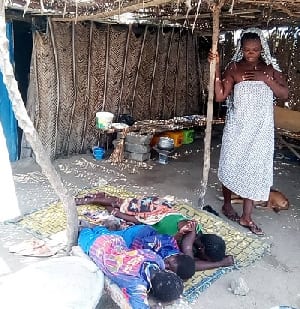Published
4 years agoon
By
Joe Pee
The fate of close to 800 people displaced by the recent sea invasion of some communities in the Ketu South Municipality remains uncertain with more tidal incursions expected in the wake of the rains.
Meanwhile, the Ministry of Works and Housing, has appointed a team from the Hydrological Services Department to engage the affected communities in a discussion to ascertain the cause of the massive demonstration undertaken by the people after the floods.
Mr Paul Alossode, Municipal Director of the National Disaster Management Organisation (NADMO) said that the Hydrological Services Department had submitted its report to the ministry, citing the desire of the people for the continuation of the second phase of the Blekusu Coastal Protection Project as the invariable cause of the demonstration.
He said that the Ministry of Works and Housing was now set to engage the Ministry of Finance for approval of the commencement of the second phase of the project.
The sea which again submerged some 100 houses in the five communities late last month has constantly ravaged the areas in the past four years.
In 2019, a similar raid on the communities by the sea destroyed 55 homes and carried away coffins from the local cemeteries.
Soon after that, NADMO responded to the disaster by erecting a mass tent for the displaced persons, but the people dismantled it and insisted on a plan to seek a permanent solution to the problem.
After the sea invasion prior to Easter celebration, angry residents of the affected communities took part in a demonstration to demand an immediate action from the government to protect the communities against the unending ravages of the sea.
Mr Alossode said that it was now clear that the sea had permanently claimed Agavedzi, Sarakope, Adina, Blekusu and Amutinu.
About 200 of the victims from some households have been building shelter for themselves on the island of Dzetagba soon after the sea invasion, in the hope of earning a living through fishing and salt mining.
Mr Alossode said that the settlers had no toilet facilities attached to the structures they had erected on the island, and that was great cause for worry.
“They go to the edge of the water defecate and that is a serious threat to their health,” he pointed out.
The majority of the displaced persons are still perching with their relatives in a state of growing uncertainty.
The disaster victims have fiercely rejected offers for relief items such as buckets and tents from the National Disaster Management Organisation (NADMO), saying such paltry offers would not solve the problem.
They insist on the sea defence wall as a permanent solution to the problem.


Video: Nana Tonardo Sprays Cash on Nana Agradaa During Church Visit


Juliet Ibrahim Champions Gender Equality with HER STEAM Initiative


Video: Funny Face Flees After Learning Lady Shares Name with His Ex


Video: Lisa Quama Revives Ghana’s Independence Spirit with Stirring Nkrumah Reenactment


Tiwa Savage Eyes Mogul Status with Bold Plans for Music and Film Industry Expansion


The 28th February Crossroads Shooting: The Spark That Ignited Ghana’s Independence


Mahama Vows to Usher in Era of Fiscal Discipline and National Renewal


Elon Musk changes his name to Kekius Maximus on X


Mahama Calls for Unity Among Political Parties to Drive Ghana’s Renaissance

























